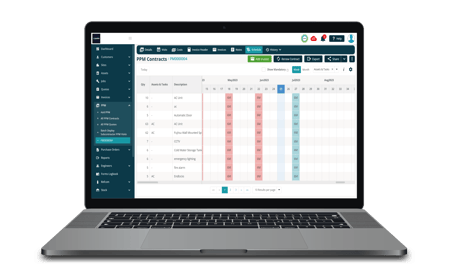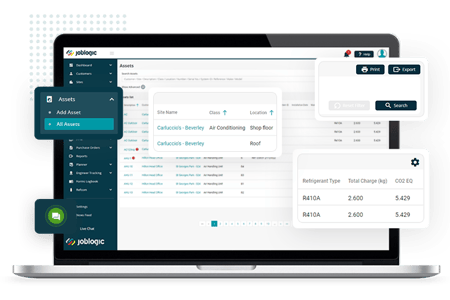
What is CAFM Software: A Comprehensive Guide to CAFM Software for Streamlining Facility Management
What is CAFM Software?
CAFM software is a digital platform designed to help facility managers efficiently handle various tasks related to the maintenance and operation of physical spaces. This software enables facility managers to keep track of maintenance schedules and optimise space utilisation while providing a centralised hub for organising essential information and streamlining workflows.
The Benefits of CAFM Software:
Centralised Data Management: One of the main benefits of using CAFM software is its capability to centralise data about facilities management. This includes floor plans, equipment inventory, maintenance schedules, occupancy data, lease agreements, and more. By consolidating information into a unified platform, managers can effortlessly access, update, and share data with relevant stakeholders, eliminating the need for manual data entry and reducing the risk of errors.
Efficient Space Utilisation: CAFM software provides managers with tools to optimise the layout of their spaces, track occupancy, and analyse utilisation. This allows managers to identify underutilised areas, reallocate space, and implement flexible work arrangements, using available resources better and reducing facility costs. Overall, the software helps enhance employee satisfaction while reducing the facility's footprint.
Streamlined Maintenance Processes: Maintaining equipment and assets is crucial for ensuring that business operations run smoothly. Computer-aided facility management (CAFM) software automates routine tasks such as scheduling inspections, generating work orders, and tracking service history.
Predictive maintenance algorithms analyse historical data to identify patterns and anticipate potential issues. This enables proactive interventions and minimises downtime.
Improved Asset Management: CAFM software is a powerful tool that helps manage assets throughout their lifecycle, from procurement and installation to maintenance and disposal. It maintains detailed asset records that accurately track each asset's status and performance. It also has barcode or RFID tracking capabilities that simplify inventory management and facilitate asset audits.
Enhanced Reporting and Analytics: CAFM software provides advanced reporting and analytics capabilities, allowing managers to gain valuable insights into facility operations and performance metrics. Customisable dashboards display key performance indicators, such as energy consumption, space utilisation, maintenance costs, and occupancy rates, which help guide strategic decision-making and resource allocation.
Streamlining Facility Management Processes:
By leveraging the capabilities of CAFM software, facility managers can streamline a wide range of processes, leading to increased efficiency, reduced costs, and improved overall performance. From centralising data management to optimising space utilisation and streamlining maintenance processes, CAFM software empowers managers to oversee facility operations effectively and make informed decisions to drive success. The most common ways that CAFM software streamlines processes in areas such as...
1) Maintenance Management

Automated Work Orders: CAFM software enables managers to automate the creation of work orders for maintenance tasks instead of manually doing them. The software generates work orders automatically and assigns them to the relevant personnel when maintenance is due based on predefined schedules or triggers.
Predictive Maintenance: Historical data on equipment performance and records can be analysed by CAFM software to predict when maintenance is likely needed. This proactive approach helps prevent unexpected breakdowns and minimises downtime.
Mobile Accessibility: Technicians can access work orders, equipment manuals, and other relevant information directly from their mobile devices using CAFM software. This streamlines communication and allows for real-time updates on maintenance activities.
2) Space Utilisation Optimisation:
Space Planning Tools: CAFM software provides various tools that help managers visualise floor plans and analyse space utilisation. With these tools, managers can quickly identify underutilised areas, reconfigure layouts, and optimise space allocation to meet changing needs.
Occupancy Tracking: Managers can track real-time occupancy data by integrating sensors or occupancy sensors with CAFM software. This information can help identify peak usage times, monitor space usage patterns, and make informed decisions about space allocation and utilisation.
Scenario Planning: CAFM software enables managers to create "what-if" scenarios to evaluate the impact of different space allocation strategies. This helps make data-driven decisions when planning renovations, expansions, or relocations.
3) Asset Management:

Asset tracking is an essential aspect of facilities management. With the help of CAFM software, managers can track the location, status, and condition of assets in real time. The use of barcode or RFID tagging can streamline inventory management and asset tracking processes, making them more efficient.
In addition, detailed maintenance records are stored in the CAFM system, providing a complete history of each asset's maintenance activities. This information helps identify trends, evaluate asset performance, and optimise maintenance schedules.
Moreover, CAFM software supports the entire lifecycle of assets, from procurement to disposal. Managers can track warranty information, depreciation, and replacement schedules, ensuring optimal asset performance and cost-effectiveness.
4) Reporting and Analytics:
Facilities management software (CAFM) offers customisable dashboards that display key performance indicators (KPIs), such as energy consumption, maintenance costs, and space utilisation metrics. This enables managers to evaluate performance and identify areas for improvement quickly.
CAFM software uses data visualisation techniques, such as charts, graphs, and heatmaps, to present complex information in a user-friendly format. This makes it easier for managers to analyse trends, identify patterns, and make data-driven decisions.
Managers can schedule automated reports to be generated regularly and distributed to relevant stakeholders. This streamlines the reporting process and ensures that decision-makers have access to timely and accurate information.